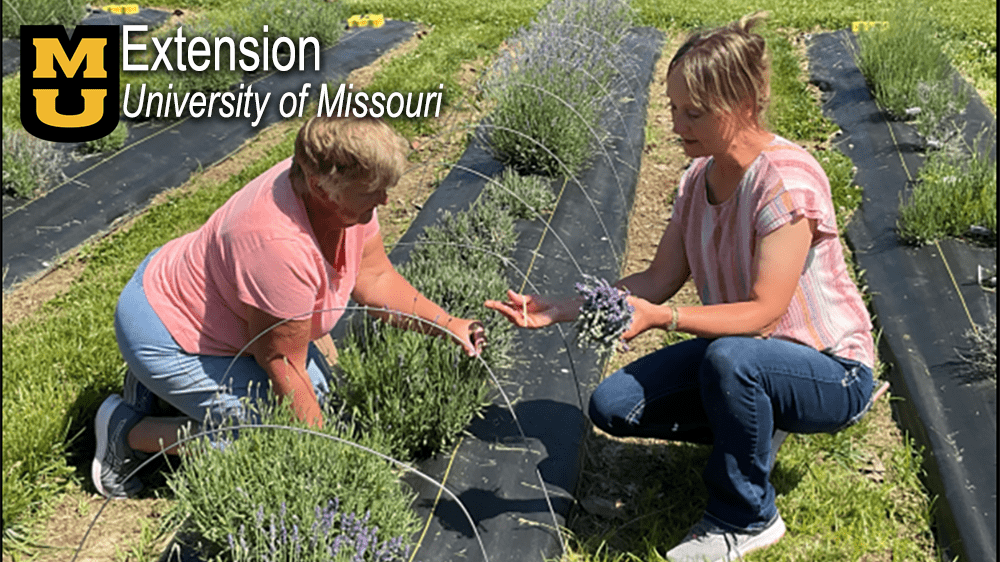
MISSOURI — A team of MU Extension Field Specialists received a Missouri Department of Agriculture Specialty Crops Block grant in January 2021, to fund a lavender research project at three sites in Missouri: Kirksville, Springfield, and Ste. Genevieve. The purpose of the project is to learn which cultivars of lavender are best suited for each site based on flower production, winter hardiness, drought hardiness and overall vigor of the plant, and provide this information to producers and home gardeners.
The project started in Kirksville in May of 2021. Over 120 lavender plants, 13 cultivars, were planted in seven raised rows with drip irrigation laid down the length of each row to provide water to plants during dry periods throughout the summer. Data was collected every two weeks from the first week of June 2021 through the end of October 2021. Data collected included height and width of the plants, vigor and in bloom/not in bloom. Based on data collected in 2021, the cultivars ‘Super’, ‘Phenomenal’, ‘Grosso’, ‘Melissa’ and ‘Provence’ performed the best.
Plants were covered in late December 2021 with row cover for winter protection. Garden staples were used to keep the covers in place. The covers were removed on March 29, and pruning was done in April to remove dead growth and shape the plants. The plants started blooming in late May with the first flower harvest of 2022 on June 3. Flower stems for each cultivar were measured, with ‘Grosso’ and ‘Provence’ having the longest stems. The flowers were weighed and weights recorded for each harvest. In 2022, the same cultivars, ‘Super’, ‘Phenomenal’, ‘Grosso’, ‘Melissa and ‘Provence’, again out-performed all the other cultivars. All these, with the exception of ‘Melissa’, had 14-21 inch stems. Stem length is important for floral arranging. ‘Grosso’ was the biggest producer of flowers. ‘Melissa’ is a white flowered cultivar, with shorter stems, but it is very pretty when arranged in bouquets with the purple cultivars.
This information has been presented at workshops, programs and through newsletters. A local producer, Titus Creek Flower Farm, near LaPlata, has made the decision to incorporate lavender into their existing operation. They planted 400 lavender plants in 2022, and will plant another 400 this spring. Their plans are to develop value-added lavender products like soap, infused honey, candles, sachets, and much more. They are currently transforming an old barn on the farm into a flower shop.
Home gardeners should consider growing lavender. It makes a beautiful addition to a garden, and there are several benefits to growing it. Apart from its beautiful color, lavender is known for its soothing scent. It has a relaxing effect and helps relieve stress. Lavender oil is a commonly used ingredient in shampoos, soaps, air fresheners, candles and scented sachets. Fresh lavender plants will keep a garden fragrant as well as attract a variety of pollinators like bees, butterflies, praying mantis and others. In urban settings where the population of natural pollinators, including bees and butterflies, is on a decline, lavender plants offer an invaluable attraction to these species.
Some insects like fleas, flies, and mosquitos don’t like lavender. Hence, growing a lavender plant in a garden may be a way to deter these unwanted insect pests. The use of lavender products on skin can serve the purpose of mosquito repellant without damaging your skin.
Lavender plants prefer full sun and a sandy-loam, well-drained soil. Water-logged or soil that is always moist or wet will cause root rot in the plants and may kill them.
For more information on growing lavender, contact me at the MU Extension Center in Adair County at 660-665-9866 or email schutterjl@missouri.edu.